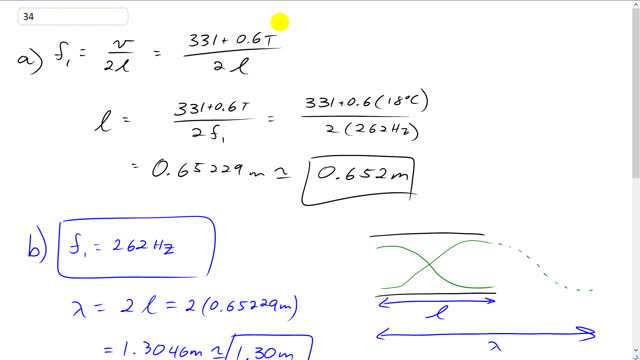
- Determine the length of an open organ pipe that emits middle C (262 Hz) when the temperature is .
- What are the wavelength and frequency of the fundamental standing wave in the tube?
- What are and in the traveling sound wave produced in the outside air?

In order to watch this solution you need to have a subscription.
This is Giancoli Answers with Mr. Dychko. The fundamental frequency for an open ended tube at both ends is v over 2 l where v is the speed of the wave in the tube but the wave in the tube is a sound wave, and so its speed is given by this formula, 331 plus 0.6 times the temperature in Celsius and divide that by 2 l and then multiplying this side by l over f1 and multiply this by l over f1. And we end up with this formula here that l which is what you get there after the f1's cancel, equals 331 plus 0.6 t divided by 2 f1. And so that's 331 plus 0.6 times 18 degrees Celsius divided by 2 times 262 hertz which is about 0.652 meters for the length of the organ tube. And, well, the frequency we're told is 262 hertz and that's going to be the fundamental. You know, when you hear a note you're actually hearing a superposition of many overtones and harmonics. But the single pitch that you identify is going to be the fundamental. And so when we're told that it's 262, then that means it's the fundamental. The wave length is going to be 2 times length of the tube, you can see that from this drawing here. Here's one wave that fits within the tube it's a displacement antinode here and a displacement antinode here, and, both of the open ends. And as you carry this long now we have one full wave form and that one full wave form is going to be 2 times the length of the tube. And so that's 2 times 0.65229 which is 1.30 meters. The frequency in air and the wave length in air are going to be the same as they are inside the pipe but just for argument's sake let's pretend that there might be different. Now, the frequencies have to be the same because it's the same... Well, you know, whatever thing is vibrating it's going to be vibrating the air beside it at the same rate. And so all things are gonna create a frequency in the air equal to the frequency on the thing that's vibrating be it the string or be it a column of air within the organ pipe and so on. So, frequency is going to be 262 hertz as for the wavelength however, it could, technically be different as it is between a string and the air, the wavelengths are different because the waves are traveling at different speeds along the string material versus through the air but, and so let's pretend that it might be different here. And we'll solve for λ by dividing both sides by f and so the wavelength in the air is the speed of the wave through the air, speed of sound in other words, divided by the frequency in the air. And so that's 331 plus 0.6 times 18 degrees Celsius divided by 262. And we get to the same to lots of precision, the same number as we had for the wavelengths inside the organ tube and that's no surprise 1.30 meters because the thing resonating inside the organ tube is air. And so we would expect to have the same wavelength outside the tube because it's air out there too.